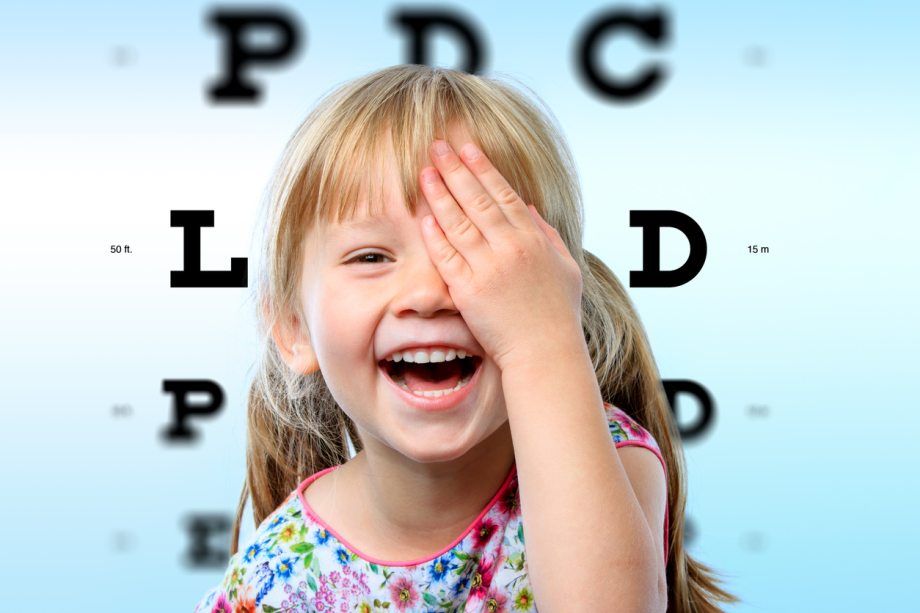Eye Care: The Childhood Years

In the United States, some insurance plans deal with eye care separately from general health care. But the eyes are part of the body, and eye problems can affect everything from learning, to social development, to general bodily health.
It’s important to understand how your child’s eyes develop, especially during the first year of life. Regular eye examinations can tell you if your child’s visual development is on track, and can help to pinpoint problems early. Other general health problems can also be picked up during eye examinations.
Your Child's Vision: The First 12 Months
Our children’s eyes are constantly growing and changing.
A baby’s vision is largely a blur. Infant eyes are very sensitive to light, which is why their pupils may appear large. They can see things using their peripheral vision, but during the first twelve months, their central vision is still developing.
In the first few weeks of life, babies can see light, shadow, and contrasting patterns. Bright colors may catch their eye. By one month of age, they may be able to focus briefly on things directly in front of them.
At two months, many babies will be able to track an object with their eyes, and around three months, the eyes should work together. At five months, depth perception has developed, and your baby may be able to recognize you from across the room.
It’s not until about ten months of age that all of these factors come together. Most babies will then be able to see well enough to grasp something between their thumb and forefinger.
A child’s vision will continue to change and develop until they’re in their late teens.
The early childhood years are a complicated time that involves a lot of rapid changes. Vision problems can be difficult to spot if you don’t know what to look for. Eye health problems can affect your child’s learning, social development, and more.
Regular eye examinations can help you to keep track of developments and spot vision problems early. What’s more, routine pediatric eye examinations can sometimes lead to a diagnosis of other health problems.
Common Eye Problems
So, what are some common childhood eye diseases and conditions you should be aware of?
Amblyopia

Amblyopia, more commonly known as “lazy eye,” is when vision in one eye doesn’t develop normally. The brain focuses on vision in the stronger eye, and ignores input from the weaker eye. It’s one of the most common causes of vision loss in children.
Amblyopia is caused by undiagnosed eye problems such as misalignment (strabismus), refractive errors, or droopy eyelids.
An ophthalmologist may treat amblyopia by having your child wear an eye patch for a short time to strengthen the weaker eye.
Eye Infection
Eye infections aren’t just painful. They can move fast, and infect other parts of the body. If you notice signs of infection such as painful swelling or bulging, fever, blurry vision, or problems with eye movement, it’s important to speak to your pediatrician immediately. It can potentially be very serious.
Pink Eye / Conjunctivitis
Pink Eye (conjunctivitis) is a bacterial infection of the white of the eye. There are different causes and types of conjunctivitis in newborns and toddlers, some of which are serious, and some of which are common and nothing to worry about.
If you think your toddler has conjunctivitis and are concerned, contact your healthcare provider. You might also want to check with their childcare provider if they are happy for them to still attend daycare, as some schools may ask that you keep your child off until their eyes are feeling better.
Conjunctivitis in newborns can be very serious. If your newborn has symptoms of conjunctivitis, they should see a doctor right away. Neonatal conjunctivitis is a red eye in a newborn caused by infection, irritation, or a blocked tear duct.
Ptosis (Droopy Eyelid)
Ptosis is the medical term used for the drooping of the upper eyelid. It can be congenital, or acquired later on in life. This can sometimes block vision and require surgery.
A child with ptosis may tip their head back, lift up their chin, or raise their eyebrows to try to see better. Over time, these movements can cause head and neck problems, and ptosis can also put a child at risk for other vision problems. Speak to your optician if you notice signs of ptosis in your child.
Refractive Errors

Refractive errors are a group of eye conditions that include nearsightedness, farsightedness, and astigmatism.
Nearsightedness (myopia) is when visual acuity is stronger when looking at things up close.
Farsightedness (presbyopia) is when one can see objects better when they’re far away.
Astigmatism means blurry vision that is caused by a misshapen cornea.
An eye specialist may prescribe glasses or eye exercises for refractive errors, and they’ll usually be picked up during routine eye examinations.
Warning Signs of Eye Conditions
The following can be signs of a range of different eye disorders. If you notice any of these signs, speak to your pediatrician or pediatric eye specialist immediately.
- Misalignment (Strabismus)
- Droopy eye
- Cloudy eye
- Eyes not tracking together
- Delays in tracking moving objects
- Signs of infection (swelling, bulging, blurry vision, fever)
- Redness
- Itching
- Discharge
Eye Conditions That Are Rare in Children
1. Cloudy Eye
Normally, the lens of the eye is clear. If it appears cloudy, it could be due to a cataract (clumps of protein that gather on the lens and cloud vision). Rarely, it could be a sign of cancer of the retina. Cataracts in children are very rare, it’s much more common in older people, so your baby or toddler will be at a low risk of this.
2. Glaucoma
Glaucoma is an eye disease that damages the optic nerve. Usually, the damage is caused by fluid buildup in the front part of the eye. Glaucoma is more common in adults over 40 years old, but most routine eye exams will test for glaucoma.
Routine Screenings
Children’s eye care is critical to eye health. The American Academy of Ophthalmology suggests the following schedule for routine screenings:
Newborns
Your pediatrician may give your infant its first eye exam. This may include a general examination for eye health, as well as a test for the "red reflex" and the blink and pupil responses.
If your baby shows signs of eye disease, or if there’s a family history of eye disease, your pediatrician may refer your child to an ophthalmologist for a comprehensive eye exam.
Six to Twelve Months
A second routine eye exam should be done between ages six and twelve months. This can be done by your pediatrician. It will include the above tests, plus an examination for alignment.
One to Three Years
A child’s eye examination during this time checks for healthy eye and vision development. Your eye care professional may perform photoscreening to examine the inside of the eyes.
Three to Five Years

A child’s eye examination during these years looks for misalignment, refractive errors, and visual acuity. Your child may be asked to read an eye chart and perform other simple activities or tasks in order to check their overall eye health.
Five Years and Above
At around five years of age, your child should be examined for visual acuity, refractive errors, misalignment, and so forth. Your eye care professional may recommend a schedule for regular eye exams after that.
They may also recommend a comprehensive eye examination which may include dilation of the pupils.
Know Your Eye Care Professionals

Different vision care professionals may examine your child’s eyes. It’s important to know who they are and what they do.
Ophthalmologist: (aka eye doctor, eye specialist) This is an M.D. with four to five years of additional training in ophthalmology.
Optometrist: An optometrist is a health professional who conducts vision screenings and eye examinations. An optometrist is generally not an M.D. but holds a Doctor of Optometry, and will be able to notice signs of eye conditions and refer your child to an ophthalmologist if necessary.
Pediatrician: A pediatrician is an M.D. who specializes in children’s medicine. Although they will have some knowledge about children’s eye health, they will not necessarily be able to pick up on the same conditions as an optometrist will.
Pediatric Eye Care Provider: An eye care professional who specializes in children’s eye care.
Keep an Eye on Visual Health
The eyes may be the window to the soul, but they’re also a window into your child’s general health. Make sure that your child’s eyes and vision are developing as they should, and always attend all of your routine checkups. It is particularly important to protect your child’s eyes when outdoors due to harmful UV rays.

